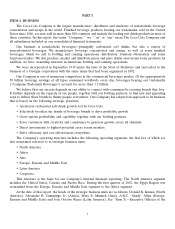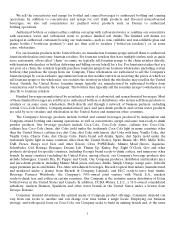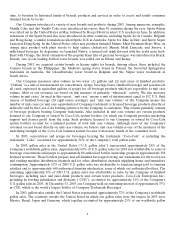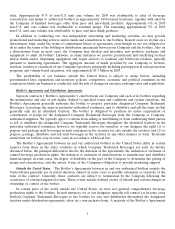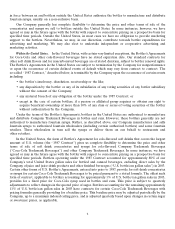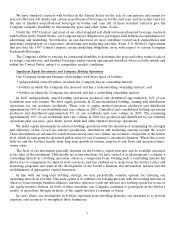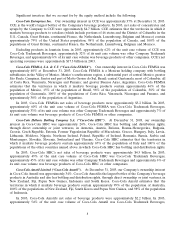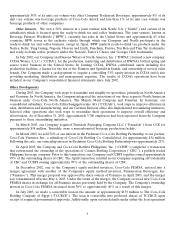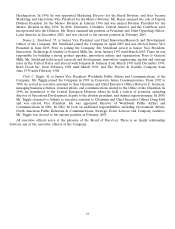Coca Cola 2003 Annual Report Download - page 13
Download and view the complete annual report
Please find page 13 of the 2003 Coca Cola annual report below. You can navigate through the pages in the report by either clicking on the pages listed below, or by using the keyword search tool below to find specific information within the annual report.
or the terms of the preferred shares, we have the ability to convert the loan or the preferred shares into common
shares. At December 31, 2003, our Company owned approximately 42% of the common shares of TCCBCE.
Effective October 1, 2003, the Company and all of its bottling partners in Japan created a nationally
integrated supply chain management company to centralize procurement, production and logistics operations
for the entire Coca-Cola system in Japan.
During the fourth quarter of 2003, we collaborated with CCE in an intensive joint strategic planning
process. We expect that this collaboration will continue to benefit both companies as we jointly focus on creating
innovative brands and packages, marketing and distributing our products more effectively, rationalizing
information technology projects, and managing costs in the supply chain more effectively. In addition, we have
committed to reexamine the economic relationship between the two companies as we seek to create greater
focus on revenue growth and improved returns on capital.
Seasonality
Sales of our ready-to-drink nonalcoholic beverages are somewhat seasonal, with the second and third
calendar quarters accounting for the highest sales volumes in the Northern Hemisphere. The volume of sales in
the beverages business may be affected by weather conditions.
Competition
Our Company competes in the nonalcoholic beverages segment of the commercial beverages industry.
Based on internally available data and a variety of industry sources, we believe that in 2003, worldwide sales of
Company products comprised approximately 10% of total worldwide sales of nonalcoholic beverage products.
The nonalcoholic beverages segment of the commercial beverages industry is highly competitive, consisting of
numerous firms. These include firms that compete, like our Company, in multiple geographical areas as well as
firms that are primarily local in operation. Competitive products include carbonates, packaged water, juices and
nectars, fruit drinks and dilutables (including syrups and powdered drinks), sports and energy drinks, coffee and
tea, still drinks and other beverages. Nonalcoholic beverages are sold to consumers in both ready-to-drink and
not-ready-to-drink form. In many of the countries in which we do business, including the United States,
PepsiCo, Inc. is a primary competitor of ours. Other significant competitors include Nestl´
e S.A., Cadbury
Schweppes plc, Groupe Danone and Kraft Foods Inc., among others.
Most of our beverages business currently is in soft drinks, as that term is defined in this report. The
soft-drink business, which is part of the nonalcoholic beverages segment, is itself highly competitive, and soft
drinks face significant competition from nonalcoholic beverages and other beverages. Our Company is the
leading seller of soft-drink concentrates and syrups in the world. Numerous firms, however, compete in that
business. These consist of a range of firms, from local to international, that compete against our Company in
numerous geographical areas.
Competitive factors with respect to our business include pricing, advertising, sales promotion programs,
product innovation, increased efficiency in production techniques, the introduction of new packaging, new
vending and dispensing equipment, and brand and trademark development and protection.
Positive aspects of our competitive position include strong brands with a high level of consumer acceptance,
a worldwide network of bottlers and distributors of Company products, sophisticated marketing capabilities and
a talented group of dedicated employees. Negative aspects of our competitive position include strong
competition in all geographic regions, and, in many countries, a concentrated retail sector with powerful buyers
able to freely choose between Company products, products of competitive beverage suppliers, and individual
retailers’ own store-brand beverages.
10



